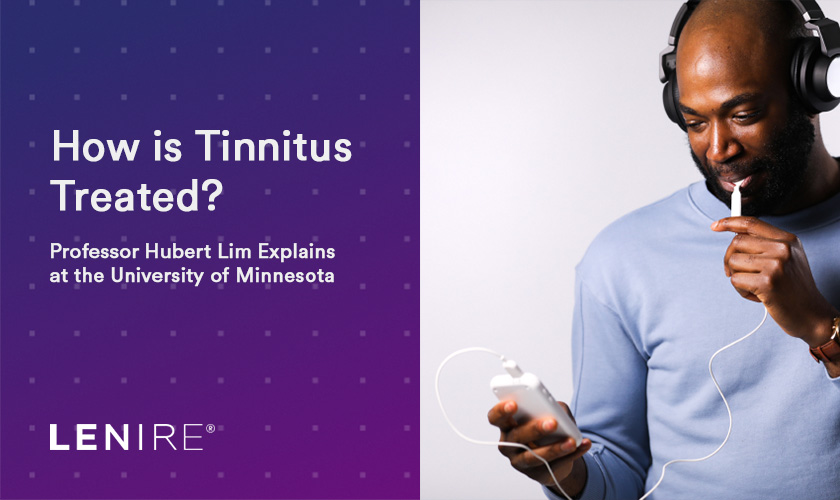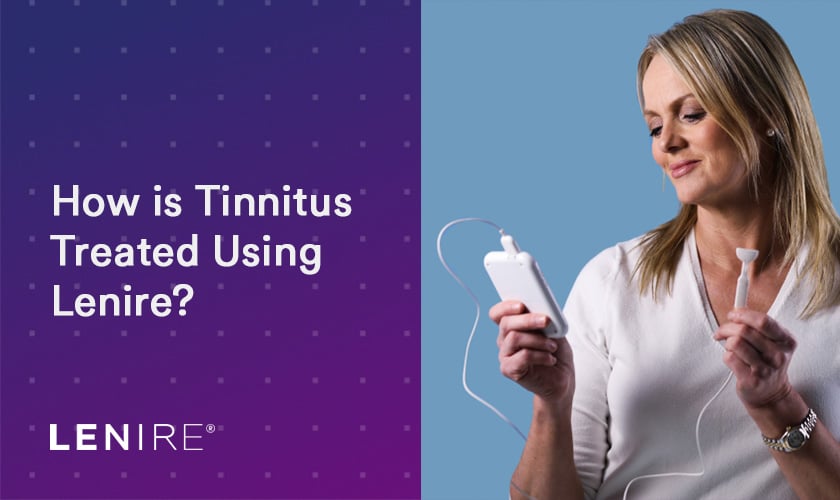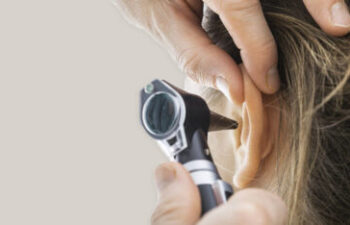How is Tinnitus Treated? Prof. Hubert Lim Explains

How is Tinnitus Treated?
How is tinnitus treated? A simple question with a complex answer. This is due to the subjective nature of tinnitus.
Neuromod Chief Scientific Officer, Hubert Lim, spoke at the University of Minnesota about the science behind Lenire. Professor Lim has an innate ability to simplify even the most complex subject matter.
Want to understand the theory behind treating tinnitus? The subject has never been so accessible as in this talk from Prof. Lim.
What is Lenire? Lenire is a breakthrough treatment device for tinnitus. It is clinically proven to soothe tinnitus symptoms for 12 months after completing treatment.
Embracing a new treatment can take a leap of faith. In particular when it comes to hearing. Watch Prof. Lim’s talk for a simplified deep dive into how tinnitus is treated.
You can also keep reading for an overview of bimodal neuromodulation. It will explain why tinnitus occurs and how different treatments work.
What is Tinnitus?

If you are one of the 10 – 15% of the global population who suffers from tinnitus, you may be thinking why do my ears ring? What causes tinnitus? And, for more experienced people – how does tinnitus treatment and Lenire work?
You may be aware that tinnitus can be either a physical or neurological condition. For this reason, treatment is quite complex. Despite being so prevalent, tinnitus is still a hidden condition.
As can be seen in Figure 1 above, there is a tinnitus-free brain on the left and a brain with tinnitus on the right. Tinnitus spikes are the triangles on the right diagram.
What is tinnitus? A person with tinnitus will sense sound with no external stimulus. Simply put, even if it is whisper quiet, a person may still perceive sound. This is commonly constant ringing in the ears but can be humming, hissing, and thumping.
Tinnitus sound is unique to a person. As a result, treatment outcomes can be subjective.
Is there a tinnitus cure? No. There is no cure for tinnitus at the moment. Consequently, the aim of therapy is to reduce the brain’s focus on the triangles. Let’s explore this idea.
Tinnitus Sound Therapy Visualised

As you can see in this example, sound therapy covers the sound of tinnitus. Sound stimulates the brain, providing something else for it to focus on instead of tinnitus. This is achieved by activating non-tinnitus cells as above.
As can be seen in the diagram above, external sound input is signaled by the circles.
However, once the sound is turned off, tinnitus usually returns to the brain’s spotlight. It is important to note that this is a simplified view of the ailment and therapy. All said, there are some positive lasting effects to sound-only therapy.
A clunky comparison for sound therapy is spraying air fresheners in a garlic warehouse. You can briefly cover the smell but as soon as you stop spraying, the garlic aroma returns.
How do you get long-term tinnitus improvement? Is there a tinnitus treatment that works? Lenire’s clinical trials suggest that it is possible to positively impact tinnitus long-term.
Before we get into how Lenire treats tinnitus, let’s look at some therapies that can help.
How is Tinnitus Treated? Types of Tinnitus Therapies
- Sound Devices: Sound devices like maskers, music therapy and hearing aids provide a variety of sounds that can treat tinnitus. These treatments are not clinically approved. Typically, once the sound stops, tinnitus returns.
- Education and Counselling: Tinnitus activity treatments. In the long run, education helps people understand their tinnitus and improve their ear care.
- Tinnitus Retraining Therapy: A combination of a mindful-based approach and sound therapy. A full profile of someone’s lifestyle is created. A specialist would then recommend improvements in lifestyle and habits.
- Cognitive Behavioural Therapy (CBT): CBT is well-known and often used. developing and practicing new coping skills. CBT can involve developing problem-solving skills, journaling, role-playing and stress management. It can lead to large improvements and long-lasting improvements. Internet-based CBT, or iCBT, has also been quite encouraging. Compliance is challenging with CBT.
- Customised Combinations: Consider the all-of-the-above approach. This is where you customise treatments for patients depending on their needs.
As shown above, Lenire uses bimodal neuromodulation. This is the combination of two stimuli that encourages the brain’s flexibility to adapt. This flexibility is referred to as neuroplasticity.
How is Tinnitus Treated? Bimodal Neuromodulation (We’ll Make it Simple-ish)

Bimodal stimulation is sound stimulation as in Figure 2. However, the sound is combined with electric pulses to the tongue. Electric pulses add ‘stickiness’ to sound treatment. This allows the positive impact to compound over multiple treatment sessions.
Neurons impacted by this stimulation are denoted by the lightning circles in Figure 3.

Bimodal allows for a longer-term treatment to be developed. As a result, more non-tinnitus cells can be activated. Over time, neuroplasticity (the brain’s flexibility to adapt) means attention will move away from the tinnitus triangles to newly focused cells. Generally, as more alternate cells light up, the impact of tinnitus on patients is diluted.
Why? The brain will always try to achieve balance. If there is more sound to focus on, tinnitus will be less present. This balance is known as homeostasis. You can see this in motion in Figure 4 above.
Playing the same sound may even cause another form of tinnitus. For this reason, It is important to vary the sounds played. Simply put, out of the frying pan and into… another frying pan.
There is more than one way to achieve bimodal neuromodulation. Through large-scale clinical trials, Neuromod confirmed that the tongue was an excellent conductor.
Lenire’s Bimodal Neuromodulation

Lenire, by Neuromod Devices, uses bimodal neuromodulation to soothe tinnitus.
Custom sounds are configured to a patient’s tinnitus profile. While sounds play, Lenire’s Tonguetip sends safe electrical pulses to the tongue. This combination of sound and tongue stimulation supports long term tinnitus changes.
Neuromod Devices has invested millions to validate Lenire’s tinnitus treatment effectiveness. In fact, 91% of compliant patients reported a big improvement in tinnitus symptoms for at least 12 months.
Read: Report from Lenire’s most recent large clinical trial – TENT-A2.
Every Lenire tinnitus treatment course is guided. Starting with initial assessment and fitting, our experts determine if Lenire is right for you. During treatment, patients get two crucial check-ins as well as support should anything unexpected occur.
Book an Ótologie Clinic Appointment to find out if Lenire is right for you. Do not worry if Lenire does not suit you, our experts can recommend alternative treatments.


